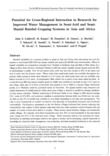Potential for Cross-Regional Interaction in Research for Improved Water Management in Semi-Arid and Semi-Humid Rainfed Cropping Systems in Asia and Africa
JIRCAS international symposium series
| ISSN | 13406108 |
|---|---|
| 書誌レコードID(総合目録DB) | AA1100908X |

本文フルテキスト
intlsymp-10_71-76.pdf219.05 KB
Rainfall variability is a common problem in areas of Asia and Africa with alternating wet and dry seasons in semi-humid (900-1400 mm annual rainfall) and semi-arid (400-900 mm) environments. Effects of rainfall variability are compared in examples from Thailand in Southeast Asia and Mali in West Africa. In a village in Khon Kaen Province, Northeast Thailand (1,092 mm annual rainfall), sample farmers reported 36% of landholdings in paddy. Over 35 plot-season units, yield was less than normal in 52% of the cases, and lack of water was the primary cause. Where water from small-scale ponds was available throughout dry periods, yields normal or better were obtained in 4 of 5 years, but where pond water was not available, crop failure occurred in 3 of 5 years. In Southeastern Mali, rainfed rice is grown in low areas called bas-fonds. In a semi-arid area (893 mm annual rainfall), good rice yields were obtained in bas-fonds in only 2 of 5 years in one village, while only 10 of 40 ha of bas-fonds were planted in rice in 2000 in a second village. Small-scale ponds, as in Thailand, could be a potential option for bas-fonds. For upland rainfed crops, temporal and spatial assessment of rainfall patterns within small areas (village or district) is needed for strategic prediction of rainy season outcomes. Weather monitoring in 29 farmers' fields in two villages in 2001 showed average CVs / week of 31%-56%, and maximum variation in precipitation between fields was 8-fold over one week. As little as only 9% of rainfall may available to crop plants depending on soil type and toposequence. The risk to far m households of rainfall variability also depends on household economic and livelihood vulnerability. Participatory assessment in the two Malian villages indicated that factors reducing risk vulnearability were number of draft animals, total cattle herd size, retail commerce, exterior financial aid, and number of months of food stock deficit or surplus. These factors varied between villages and households within villages. For example, food deficit households were only 10% of total households in the semi-humid zone village but 51 % in the semi-arid zone village. These examples indicate the potential for cross-fertilization in extending technologies tested in one region to another and in developing a global framework of knowledge for improved water management, crop production, and farm household livelihoods in the semi-arid and semi-humid tropics.
| 作成者 | John S. Caldwell H. Kanno M. Doumbia K. Ozawa A. Berthé T. Sakurai K. Sasaki A. Yoroté S. Sukchan C. Ogura W. On-ok Y. Yamamoto C. Satravaha P. Prapin |
|---|---|
| 公開者 | Japan International Research Center for Agricultural Sciences |
| オンライン掲載日 | |
| 号 | 10 |
| 開始ページ | 71 |
| 終了ページ | 76 |
| 言語 | eng |
